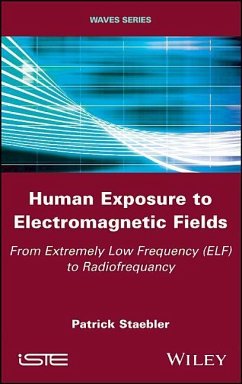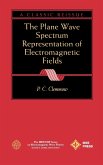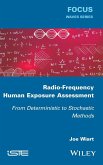Patrick Staebler
Human Exposure to Electromagnetic Fields
From Extremely Low Frequency (Elf) to Radiofrequency
Patrick Staebler
Human Exposure to Electromagnetic Fields
From Extremely Low Frequency (Elf) to Radiofrequency
- Gebundenes Buch
- Merkliste
- Auf die Merkliste
- Bewerten Bewerten
- Teilen
- Produkt teilen
- Produkterinnerung
- Produkterinnerung
Everyone, whether they like it or not, is exposed to electromagnetic fields, most of the time, at very low levels. In this case, they are inconsequential, but they can cause adverse health effects when they become intense enough. This topic is complex and sensitive. Covering frequencies from 0 Hz to 300 GHz, Human Exposure to Electromagnetic Fields provides an overview of this vast topic. After a reminder of the concepts of electromagnetic fields, the author presents some examples of sources of radiation in daily life and in the industrial or medical sectors. The biophysical and biological…mehr
Andere Kunden interessierten sich auch für
![Singular Electromagnetic Fields and Sources Singular Electromagnetic Fields and Sources]() Jean G van BladelSingular Electromagnetic Fields and Sources204,99 €
Jean G van BladelSingular Electromagnetic Fields and Sources204,99 €![Theory and Computation of Electromagnetic Fields in Layered Media Theory and Computation of Electromagnetic Fields in Layered Media]() Vladimir OkhmatovskiTheory and Computation of Electromagnetic Fields in Layered Media151,99 €
Vladimir OkhmatovskiTheory and Computation of Electromagnetic Fields in Layered Media151,99 €![The Plane Wave Spectrum Representation of Electromagnetic Fields The Plane Wave Spectrum Representation of Electromagnetic Fields]() P C ClemmowThe Plane Wave Spectrum Representation of Electromagnetic Fields158,99 €
P C ClemmowThe Plane Wave Spectrum Representation of Electromagnetic Fields158,99 €![Radio-Frequency Human Exposure Assessment Radio-Frequency Human Exposure Assessment]() Joe WiartRadio-Frequency Human Exposure Assessment186,99 €
Joe WiartRadio-Frequency Human Exposure Assessment186,99 €![Time-Harmonic Electromagnetic Fields Time-Harmonic Electromagnetic Fields]() Roger F. HarringtonTime-Harmonic Electromagnetic Fields207,99 €
Roger F. HarringtonTime-Harmonic Electromagnetic Fields207,99 €![Electromagnetic Fields for Engineers Electromagnetic Fields for Engineers]() Daniel S ElliottElectromagnetic Fields for Engineers95,99 €
Daniel S ElliottElectromagnetic Fields for Engineers95,99 €![Electromagnetic Fields 2E Electromagnetic Fields 2E]() Jean G. Van BladelElectromagnetic Fields 2E251,99 €
Jean G. Van BladelElectromagnetic Fields 2E251,99 €-
-
-
Everyone, whether they like it or not, is exposed to electromagnetic fields, most of the time, at very low levels. In this case, they are inconsequential, but they can cause adverse health effects when they become intense enough. This topic is complex and sensitive. Covering frequencies from 0 Hz to 300 GHz, Human Exposure to Electromagnetic Fields provides an overview of this vast topic. After a reminder of the concepts of electromagnetic fields, the author presents some examples of sources of radiation in daily life and in the industrial or medical sectors. The biophysical and biological effects of these fields on the human body are detailed and the exposure limits are recalled. The exposure assessment and the implementation of the appropriate regulation within companies are also covered. Technically and practically, this book is aimed at people with a scientific background, risk prevention actors, health physicians, especially occupational doctors, and equipment designers.
Hinweis: Dieser Artikel kann nur an eine deutsche Lieferadresse ausgeliefert werden.
Hinweis: Dieser Artikel kann nur an eine deutsche Lieferadresse ausgeliefert werden.
Produktdetails
- Produktdetails
- Verlag: Wiley
- Seitenzahl: 432
- Erscheinungstermin: 26. Juni 2017
- Englisch
- Abmessung: 244mm x 161mm x 30mm
- Gewicht: 768g
- ISBN-13: 9781786301215
- ISBN-10: 1786301210
- Artikelnr.: 48032729
- Herstellerkennzeichnung
- Libri GmbH
- Europaallee 1
- 36244 Bad Hersfeld
- gpsr@libri.de
- Verlag: Wiley
- Seitenzahl: 432
- Erscheinungstermin: 26. Juni 2017
- Englisch
- Abmessung: 244mm x 161mm x 30mm
- Gewicht: 768g
- ISBN-13: 9781786301215
- ISBN-10: 1786301210
- Artikelnr.: 48032729
- Herstellerkennzeichnung
- Libri GmbH
- Europaallee 1
- 36244 Bad Hersfeld
- gpsr@libri.de
Patrick Staebler received is an advisor to companies concerned about exposure to electromagnetic fields in implantation of regulations (e.g. Directive 2013/35/UE), in the design of their products (intended for the general public and professionals) and the preparation of certificates of compliance. He is also a member of the French Society of Radiation Protection, non-ionizing radiation section (SFRP-RNI).
Preface xi
Acknowledgments xix
Chapter 1 Concepts of Electromagnetic Fields 1
1.1 Concepts of fields 1
1.1.1 Introduction 1
1.1.2 Electric fields 3
1.1.3 Magnetic fields 6
1.1.4 Introduction to electromagnetic fields 10
1.2 Waves, frequencies and wavelengths 12
1.2.1 Waves 12
1.2.2 Frequencies and periods 13
1.2.3 Wavelengths 14
1.3 Propagation of electromagnetic waves 15
1.3.1 Propagation in free space 15
1.3.2 Polarization of the wave 21
1.3.3 Near field/far field 21
1.3.4 Propagation in a real environment 24
1.3.5 Summary of electromagnetic waves 25
1.4 Type of radiation 25
1.4.1 Ionizing radiations 26
1.4.2 Non-ionizing radiations 27
1.4.3 Electromagnetic spectrum 27
1.4.4 Frequency bands 29
1.4.5 Area of exposure to electromagnetic fields 32
1.4.6 Summary of electromagnetic radiations 33
Chapter 2 Sources of Electromagnetic Fields 35
2.1 Natural fields 35
2.1.1 Electric fields 35
2.1.2 Magnetic fields 36
2.1.3 Electromagnetic fields 36
2.2 Artificial fields 36
2.2.1 Static and quasi-static fields 37
2.2.2 Low-frequency fields 45
2.2.3 HF fields 59
2.2.4 Summary of sources 86
Chapter 3 Biophysical Mechanisms 89
3.1 Interactions with matter 90
3.1.1 Matter exposed to an electric field 91
3.1.2 Matter exposed to a magnetic field 100
3.1.3 Summary of matter 102
3.2 Interaction with biological tissues 102
3.2.1 Electrical characteristics of biological tissues 102
3.2.2 Summary of biological tissues 106
3.2.3 Penetration of fields in biological tissues 107
3.2.4 Wave absorption and specific absorption rate 110
3.2.5 Summary of field absorption 112
3.3 Coupling with the human body 113
3.3.1 Low-frequency electric field coupling 113
3.3.2 Low-frequency magnetic field coupling 117
3.3.3 Electromagnetic field coupling 118
3.3.4 Summary of coupling mechanisms 123
Chapter 4 Biological Effects of Electromagnetic Fields 125
4.1 Direct effects 126
4.1.1 Direct effects of low-frequency fields 127
4.1.2 Direct effects of static magnetic fields (
4.1.3 Direct effects at frequencies between 100 kHz and 300 GHz 133
4.1.4 Summary of direct biological effects 137
4.1.5 Long-term effects of electromagnetic fields 138
4.2 Indirect effects 149
4.2.1 General 149
4.2.2 Indirect effects caused by contact currents 150
4.2.3 Indirect effects caused by static magnetic fields 152
Chapter 5 Exposure Limits for Electromagnetic Fields 153
5.1 General considerations 153
5.1.1 Recommendation 1999/519/EC 155
5.1.2 Directive 2013/35/EU 155
5.2 Low-frequency limits for direct effects 156
5.2.1 Basic restrictions, ELVs at low frequencies 156
5.2.2 Reference levels or action levels at low frequencies 162
5.3 Limits for magnetic fields
5.3.1 Basic restrictions for static magnetic fields 175
5.3.2 Basic restrictions for quasi-static magnetic fields 176
5.3.3 Reference levels for static magnetic fields 177
5.4 High frequency limits for direct effects 178
5.4.1 High-frequency basic restrictions or ELVs 178
5.4.2 High-frequency reference levels and action values 181
5.4.3 Limits for induced currents 184
5.4.4 Summary of limits for high frequencies 186
5.5 Limits for indirect effects 186
5.5.1 Limits for contact currents 187
5.5.2 Limits for electric fields, indirect effects 188
5.5.3 Limits for static magnetic fields, indirect effects 188
5.6 Summary of exposure limits 189
5.7 People at particular risk 191
5.7.1 People with medical devices 192
5.7.2 Active medical devices 192
5.7.3 Passive medical devices 197
5.7.4 Limits for active implants 197
5.7.5 Pregnant women 199
Chapter 6 Exposure Indices 201
6.1 General introduction 201
6.2 Signals and definitions 202
6.2.1 Sinusoidal signal 202
6.2.2 Complex signal 203
6.2.3 rms value of a complex signal (example) 207
6.3 Introduction to exposure indices 208
6.4 Exposure index for high-frequency fields 208
6.4.1 Exposure to a single frequency greater than 100 kHz 208
6.4.2 Exposure to multiple frequencies 210
6.5 Exposure Index for low-frequency fields 212
6.5.1 Exposure to a low-frequency sinusoidal signal 213
6.5.2 Exposure to a signal of complex form 214
6.5.3 Comparison of weighted peak techniques 225
6.6 EIs: contact currents and induced currents 228
6.7 Summary of exposure indices 229
Chapter 7 Applications of Exposure Indices 233
7.1 Introduction 233
7.2 Theoretical signals 234
7.2.1 Example 1: two incoherent sinusoidal signals with similar frequencies
235
7.2.2 Example 2: signal made up of two coherent sinusoidal signals
(influence of the phase) 239
7.2.3 Example 3: signal made up of two sinusoidal signals with very
different frequencies 242
7.2.4 Example 4: burst 244
7.2.5 Example 5: "chopped" sinusoidal signal 246
7.2.6 Example 6: square signal 249
7.3 Real signals 255
7.3.1 Example 7: hand-held electric drill 255
7.3.2 Example 8: welding gun 259
7.3.3 Example 9: transcranial stimulation device 264
7.4 Conclusion on the index calculation examples 265
Chapter 8 Exposure Assessment 267
8.1 Introduction 267
8.1.1 Theoretical approach 268
8.1.2 Numerical approach 269
8.1.3 Metrological approach 269
8.2 Measurement: general 269
8.2.1 Process 269
8.2.2 Measuring device requirements 272
8.3 Measuring low-frequency fields 275
8.3.1 General 275
8.3.2 Measuring low-frequency magnetic fields 276
8.3.3 Measuring a static magnetic field 284
8.3.4 Measuring low-frequency electric fields 285
8.4 Measuring high-frequency electromagnetic fields 292
8.4.1 General 292
8.4.2 Measuring sensors for electromagnetic fields 292
8.4.3 Measuring device for high-frequency electromagnetic fields 295
8.4.4 Measuring high-frequency electromagnetic fields 299
8.4.5 Calibration of the measuring chain for electromagnetic fields 301
8.4.6 Sources of uncertainty in measurements of HF electromagnetic fields
301
8.5 Measuring the contact current and induced current 304
8.5.1 Measuring the contact current (indirect effect) 304
8.5.2 Measuring an induced current (direct effect) 305
8.6 Introduction to dosimetry 307
8.6.1 Definition 307
8.6.2 Experimental dosimetry 309
8.6.3 Theoretical dosimetry 313
8.6.4 Summary of dosimetry 321
Chapter 9 Implementation of Directive 2013/35/EU 323
9.1 Context of the directive 324
9.1.1 Introduction 324
9.1.2 EMF directive development 325
9.2 Implementation of the directive 327
9.2.1 Introduction 327
9.2.2 Preliminary phase 328
9.2.3 Risk assessment 334
9.2.4 Risk prevention 346
9.2.5 Other activities 352
Appendix 1 357
Appendix 2 363
Glossary 377
Bibliography 385
Index 397
Acknowledgments xix
Chapter 1 Concepts of Electromagnetic Fields 1
1.1 Concepts of fields 1
1.1.1 Introduction 1
1.1.2 Electric fields 3
1.1.3 Magnetic fields 6
1.1.4 Introduction to electromagnetic fields 10
1.2 Waves, frequencies and wavelengths 12
1.2.1 Waves 12
1.2.2 Frequencies and periods 13
1.2.3 Wavelengths 14
1.3 Propagation of electromagnetic waves 15
1.3.1 Propagation in free space 15
1.3.2 Polarization of the wave 21
1.3.3 Near field/far field 21
1.3.4 Propagation in a real environment 24
1.3.5 Summary of electromagnetic waves 25
1.4 Type of radiation 25
1.4.1 Ionizing radiations 26
1.4.2 Non-ionizing radiations 27
1.4.3 Electromagnetic spectrum 27
1.4.4 Frequency bands 29
1.4.5 Area of exposure to electromagnetic fields 32
1.4.6 Summary of electromagnetic radiations 33
Chapter 2 Sources of Electromagnetic Fields 35
2.1 Natural fields 35
2.1.1 Electric fields 35
2.1.2 Magnetic fields 36
2.1.3 Electromagnetic fields 36
2.2 Artificial fields 36
2.2.1 Static and quasi-static fields 37
2.2.2 Low-frequency fields 45
2.2.3 HF fields 59
2.2.4 Summary of sources 86
Chapter 3 Biophysical Mechanisms 89
3.1 Interactions with matter 90
3.1.1 Matter exposed to an electric field 91
3.1.2 Matter exposed to a magnetic field 100
3.1.3 Summary of matter 102
3.2 Interaction with biological tissues 102
3.2.1 Electrical characteristics of biological tissues 102
3.2.2 Summary of biological tissues 106
3.2.3 Penetration of fields in biological tissues 107
3.2.4 Wave absorption and specific absorption rate 110
3.2.5 Summary of field absorption 112
3.3 Coupling with the human body 113
3.3.1 Low-frequency electric field coupling 113
3.3.2 Low-frequency magnetic field coupling 117
3.3.3 Electromagnetic field coupling 118
3.3.4 Summary of coupling mechanisms 123
Chapter 4 Biological Effects of Electromagnetic Fields 125
4.1 Direct effects 126
4.1.1 Direct effects of low-frequency fields 127
4.1.2 Direct effects of static magnetic fields (
4.1.3 Direct effects at frequencies between 100 kHz and 300 GHz 133
4.1.4 Summary of direct biological effects 137
4.1.5 Long-term effects of electromagnetic fields 138
4.2 Indirect effects 149
4.2.1 General 149
4.2.2 Indirect effects caused by contact currents 150
4.2.3 Indirect effects caused by static magnetic fields 152
Chapter 5 Exposure Limits for Electromagnetic Fields 153
5.1 General considerations 153
5.1.1 Recommendation 1999/519/EC 155
5.1.2 Directive 2013/35/EU 155
5.2 Low-frequency limits for direct effects 156
5.2.1 Basic restrictions, ELVs at low frequencies 156
5.2.2 Reference levels or action levels at low frequencies 162
5.3 Limits for magnetic fields
5.3.1 Basic restrictions for static magnetic fields 175
5.3.2 Basic restrictions for quasi-static magnetic fields 176
5.3.3 Reference levels for static magnetic fields 177
5.4 High frequency limits for direct effects 178
5.4.1 High-frequency basic restrictions or ELVs 178
5.4.2 High-frequency reference levels and action values 181
5.4.3 Limits for induced currents 184
5.4.4 Summary of limits for high frequencies 186
5.5 Limits for indirect effects 186
5.5.1 Limits for contact currents 187
5.5.2 Limits for electric fields, indirect effects 188
5.5.3 Limits for static magnetic fields, indirect effects 188
5.6 Summary of exposure limits 189
5.7 People at particular risk 191
5.7.1 People with medical devices 192
5.7.2 Active medical devices 192
5.7.3 Passive medical devices 197
5.7.4 Limits for active implants 197
5.7.5 Pregnant women 199
Chapter 6 Exposure Indices 201
6.1 General introduction 201
6.2 Signals and definitions 202
6.2.1 Sinusoidal signal 202
6.2.2 Complex signal 203
6.2.3 rms value of a complex signal (example) 207
6.3 Introduction to exposure indices 208
6.4 Exposure index for high-frequency fields 208
6.4.1 Exposure to a single frequency greater than 100 kHz 208
6.4.2 Exposure to multiple frequencies 210
6.5 Exposure Index for low-frequency fields 212
6.5.1 Exposure to a low-frequency sinusoidal signal 213
6.5.2 Exposure to a signal of complex form 214
6.5.3 Comparison of weighted peak techniques 225
6.6 EIs: contact currents and induced currents 228
6.7 Summary of exposure indices 229
Chapter 7 Applications of Exposure Indices 233
7.1 Introduction 233
7.2 Theoretical signals 234
7.2.1 Example 1: two incoherent sinusoidal signals with similar frequencies
235
7.2.2 Example 2: signal made up of two coherent sinusoidal signals
(influence of the phase) 239
7.2.3 Example 3: signal made up of two sinusoidal signals with very
different frequencies 242
7.2.4 Example 4: burst 244
7.2.5 Example 5: "chopped" sinusoidal signal 246
7.2.6 Example 6: square signal 249
7.3 Real signals 255
7.3.1 Example 7: hand-held electric drill 255
7.3.2 Example 8: welding gun 259
7.3.3 Example 9: transcranial stimulation device 264
7.4 Conclusion on the index calculation examples 265
Chapter 8 Exposure Assessment 267
8.1 Introduction 267
8.1.1 Theoretical approach 268
8.1.2 Numerical approach 269
8.1.3 Metrological approach 269
8.2 Measurement: general 269
8.2.1 Process 269
8.2.2 Measuring device requirements 272
8.3 Measuring low-frequency fields 275
8.3.1 General 275
8.3.2 Measuring low-frequency magnetic fields 276
8.3.3 Measuring a static magnetic field 284
8.3.4 Measuring low-frequency electric fields 285
8.4 Measuring high-frequency electromagnetic fields 292
8.4.1 General 292
8.4.2 Measuring sensors for electromagnetic fields 292
8.4.3 Measuring device for high-frequency electromagnetic fields 295
8.4.4 Measuring high-frequency electromagnetic fields 299
8.4.5 Calibration of the measuring chain for electromagnetic fields 301
8.4.6 Sources of uncertainty in measurements of HF electromagnetic fields
301
8.5 Measuring the contact current and induced current 304
8.5.1 Measuring the contact current (indirect effect) 304
8.5.2 Measuring an induced current (direct effect) 305
8.6 Introduction to dosimetry 307
8.6.1 Definition 307
8.6.2 Experimental dosimetry 309
8.6.3 Theoretical dosimetry 313
8.6.4 Summary of dosimetry 321
Chapter 9 Implementation of Directive 2013/35/EU 323
9.1 Context of the directive 324
9.1.1 Introduction 324
9.1.2 EMF directive development 325
9.2 Implementation of the directive 327
9.2.1 Introduction 327
9.2.2 Preliminary phase 328
9.2.3 Risk assessment 334
9.2.4 Risk prevention 346
9.2.5 Other activities 352
Appendix 1 357
Appendix 2 363
Glossary 377
Bibliography 385
Index 397
Preface xi
Acknowledgments xix
Chapter 1 Concepts of Electromagnetic Fields 1
1.1 Concepts of fields 1
1.1.1 Introduction 1
1.1.2 Electric fields 3
1.1.3 Magnetic fields 6
1.1.4 Introduction to electromagnetic fields 10
1.2 Waves, frequencies and wavelengths 12
1.2.1 Waves 12
1.2.2 Frequencies and periods 13
1.2.3 Wavelengths 14
1.3 Propagation of electromagnetic waves 15
1.3.1 Propagation in free space 15
1.3.2 Polarization of the wave 21
1.3.3 Near field/far field 21
1.3.4 Propagation in a real environment 24
1.3.5 Summary of electromagnetic waves 25
1.4 Type of radiation 25
1.4.1 Ionizing radiations 26
1.4.2 Non-ionizing radiations 27
1.4.3 Electromagnetic spectrum 27
1.4.4 Frequency bands 29
1.4.5 Area of exposure to electromagnetic fields 32
1.4.6 Summary of electromagnetic radiations 33
Chapter 2 Sources of Electromagnetic Fields 35
2.1 Natural fields 35
2.1.1 Electric fields 35
2.1.2 Magnetic fields 36
2.1.3 Electromagnetic fields 36
2.2 Artificial fields 36
2.2.1 Static and quasi-static fields 37
2.2.2 Low-frequency fields 45
2.2.3 HF fields 59
2.2.4 Summary of sources 86
Chapter 3 Biophysical Mechanisms 89
3.1 Interactions with matter 90
3.1.1 Matter exposed to an electric field 91
3.1.2 Matter exposed to a magnetic field 100
3.1.3 Summary of matter 102
3.2 Interaction with biological tissues 102
3.2.1 Electrical characteristics of biological tissues 102
3.2.2 Summary of biological tissues 106
3.2.3 Penetration of fields in biological tissues 107
3.2.4 Wave absorption and specific absorption rate 110
3.2.5 Summary of field absorption 112
3.3 Coupling with the human body 113
3.3.1 Low-frequency electric field coupling 113
3.3.2 Low-frequency magnetic field coupling 117
3.3.3 Electromagnetic field coupling 118
3.3.4 Summary of coupling mechanisms 123
Chapter 4 Biological Effects of Electromagnetic Fields 125
4.1 Direct effects 126
4.1.1 Direct effects of low-frequency fields 127
4.1.2 Direct effects of static magnetic fields (
4.1.3 Direct effects at frequencies between 100 kHz and 300 GHz 133
4.1.4 Summary of direct biological effects 137
4.1.5 Long-term effects of electromagnetic fields 138
4.2 Indirect effects 149
4.2.1 General 149
4.2.2 Indirect effects caused by contact currents 150
4.2.3 Indirect effects caused by static magnetic fields 152
Chapter 5 Exposure Limits for Electromagnetic Fields 153
5.1 General considerations 153
5.1.1 Recommendation 1999/519/EC 155
5.1.2 Directive 2013/35/EU 155
5.2 Low-frequency limits for direct effects 156
5.2.1 Basic restrictions, ELVs at low frequencies 156
5.2.2 Reference levels or action levels at low frequencies 162
5.3 Limits for magnetic fields
5.3.1 Basic restrictions for static magnetic fields 175
5.3.2 Basic restrictions for quasi-static magnetic fields 176
5.3.3 Reference levels for static magnetic fields 177
5.4 High frequency limits for direct effects 178
5.4.1 High-frequency basic restrictions or ELVs 178
5.4.2 High-frequency reference levels and action values 181
5.4.3 Limits for induced currents 184
5.4.4 Summary of limits for high frequencies 186
5.5 Limits for indirect effects 186
5.5.1 Limits for contact currents 187
5.5.2 Limits for electric fields, indirect effects 188
5.5.3 Limits for static magnetic fields, indirect effects 188
5.6 Summary of exposure limits 189
5.7 People at particular risk 191
5.7.1 People with medical devices 192
5.7.2 Active medical devices 192
5.7.3 Passive medical devices 197
5.7.4 Limits for active implants 197
5.7.5 Pregnant women 199
Chapter 6 Exposure Indices 201
6.1 General introduction 201
6.2 Signals and definitions 202
6.2.1 Sinusoidal signal 202
6.2.2 Complex signal 203
6.2.3 rms value of a complex signal (example) 207
6.3 Introduction to exposure indices 208
6.4 Exposure index for high-frequency fields 208
6.4.1 Exposure to a single frequency greater than 100 kHz 208
6.4.2 Exposure to multiple frequencies 210
6.5 Exposure Index for low-frequency fields 212
6.5.1 Exposure to a low-frequency sinusoidal signal 213
6.5.2 Exposure to a signal of complex form 214
6.5.3 Comparison of weighted peak techniques 225
6.6 EIs: contact currents and induced currents 228
6.7 Summary of exposure indices 229
Chapter 7 Applications of Exposure Indices 233
7.1 Introduction 233
7.2 Theoretical signals 234
7.2.1 Example 1: two incoherent sinusoidal signals with similar frequencies
235
7.2.2 Example 2: signal made up of two coherent sinusoidal signals
(influence of the phase) 239
7.2.3 Example 3: signal made up of two sinusoidal signals with very
different frequencies 242
7.2.4 Example 4: burst 244
7.2.5 Example 5: "chopped" sinusoidal signal 246
7.2.6 Example 6: square signal 249
7.3 Real signals 255
7.3.1 Example 7: hand-held electric drill 255
7.3.2 Example 8: welding gun 259
7.3.3 Example 9: transcranial stimulation device 264
7.4 Conclusion on the index calculation examples 265
Chapter 8 Exposure Assessment 267
8.1 Introduction 267
8.1.1 Theoretical approach 268
8.1.2 Numerical approach 269
8.1.3 Metrological approach 269
8.2 Measurement: general 269
8.2.1 Process 269
8.2.2 Measuring device requirements 272
8.3 Measuring low-frequency fields 275
8.3.1 General 275
8.3.2 Measuring low-frequency magnetic fields 276
8.3.3 Measuring a static magnetic field 284
8.3.4 Measuring low-frequency electric fields 285
8.4 Measuring high-frequency electromagnetic fields 292
8.4.1 General 292
8.4.2 Measuring sensors for electromagnetic fields 292
8.4.3 Measuring device for high-frequency electromagnetic fields 295
8.4.4 Measuring high-frequency electromagnetic fields 299
8.4.5 Calibration of the measuring chain for electromagnetic fields 301
8.4.6 Sources of uncertainty in measurements of HF electromagnetic fields
301
8.5 Measuring the contact current and induced current 304
8.5.1 Measuring the contact current (indirect effect) 304
8.5.2 Measuring an induced current (direct effect) 305
8.6 Introduction to dosimetry 307
8.6.1 Definition 307
8.6.2 Experimental dosimetry 309
8.6.3 Theoretical dosimetry 313
8.6.4 Summary of dosimetry 321
Chapter 9 Implementation of Directive 2013/35/EU 323
9.1 Context of the directive 324
9.1.1 Introduction 324
9.1.2 EMF directive development 325
9.2 Implementation of the directive 327
9.2.1 Introduction 327
9.2.2 Preliminary phase 328
9.2.3 Risk assessment 334
9.2.4 Risk prevention 346
9.2.5 Other activities 352
Appendix 1 357
Appendix 2 363
Glossary 377
Bibliography 385
Index 397
Acknowledgments xix
Chapter 1 Concepts of Electromagnetic Fields 1
1.1 Concepts of fields 1
1.1.1 Introduction 1
1.1.2 Electric fields 3
1.1.3 Magnetic fields 6
1.1.4 Introduction to electromagnetic fields 10
1.2 Waves, frequencies and wavelengths 12
1.2.1 Waves 12
1.2.2 Frequencies and periods 13
1.2.3 Wavelengths 14
1.3 Propagation of electromagnetic waves 15
1.3.1 Propagation in free space 15
1.3.2 Polarization of the wave 21
1.3.3 Near field/far field 21
1.3.4 Propagation in a real environment 24
1.3.5 Summary of electromagnetic waves 25
1.4 Type of radiation 25
1.4.1 Ionizing radiations 26
1.4.2 Non-ionizing radiations 27
1.4.3 Electromagnetic spectrum 27
1.4.4 Frequency bands 29
1.4.5 Area of exposure to electromagnetic fields 32
1.4.6 Summary of electromagnetic radiations 33
Chapter 2 Sources of Electromagnetic Fields 35
2.1 Natural fields 35
2.1.1 Electric fields 35
2.1.2 Magnetic fields 36
2.1.3 Electromagnetic fields 36
2.2 Artificial fields 36
2.2.1 Static and quasi-static fields 37
2.2.2 Low-frequency fields 45
2.2.3 HF fields 59
2.2.4 Summary of sources 86
Chapter 3 Biophysical Mechanisms 89
3.1 Interactions with matter 90
3.1.1 Matter exposed to an electric field 91
3.1.2 Matter exposed to a magnetic field 100
3.1.3 Summary of matter 102
3.2 Interaction with biological tissues 102
3.2.1 Electrical characteristics of biological tissues 102
3.2.2 Summary of biological tissues 106
3.2.3 Penetration of fields in biological tissues 107
3.2.4 Wave absorption and specific absorption rate 110
3.2.5 Summary of field absorption 112
3.3 Coupling with the human body 113
3.3.1 Low-frequency electric field coupling 113
3.3.2 Low-frequency magnetic field coupling 117
3.3.3 Electromagnetic field coupling 118
3.3.4 Summary of coupling mechanisms 123
Chapter 4 Biological Effects of Electromagnetic Fields 125
4.1 Direct effects 126
4.1.1 Direct effects of low-frequency fields 127
4.1.2 Direct effects of static magnetic fields (
4.1.3 Direct effects at frequencies between 100 kHz and 300 GHz 133
4.1.4 Summary of direct biological effects 137
4.1.5 Long-term effects of electromagnetic fields 138
4.2 Indirect effects 149
4.2.1 General 149
4.2.2 Indirect effects caused by contact currents 150
4.2.3 Indirect effects caused by static magnetic fields 152
Chapter 5 Exposure Limits for Electromagnetic Fields 153
5.1 General considerations 153
5.1.1 Recommendation 1999/519/EC 155
5.1.2 Directive 2013/35/EU 155
5.2 Low-frequency limits for direct effects 156
5.2.1 Basic restrictions, ELVs at low frequencies 156
5.2.2 Reference levels or action levels at low frequencies 162
5.3 Limits for magnetic fields
5.3.1 Basic restrictions for static magnetic fields 175
5.3.2 Basic restrictions for quasi-static magnetic fields 176
5.3.3 Reference levels for static magnetic fields 177
5.4 High frequency limits for direct effects 178
5.4.1 High-frequency basic restrictions or ELVs 178
5.4.2 High-frequency reference levels and action values 181
5.4.3 Limits for induced currents 184
5.4.4 Summary of limits for high frequencies 186
5.5 Limits for indirect effects 186
5.5.1 Limits for contact currents 187
5.5.2 Limits for electric fields, indirect effects 188
5.5.3 Limits for static magnetic fields, indirect effects 188
5.6 Summary of exposure limits 189
5.7 People at particular risk 191
5.7.1 People with medical devices 192
5.7.2 Active medical devices 192
5.7.3 Passive medical devices 197
5.7.4 Limits for active implants 197
5.7.5 Pregnant women 199
Chapter 6 Exposure Indices 201
6.1 General introduction 201
6.2 Signals and definitions 202
6.2.1 Sinusoidal signal 202
6.2.2 Complex signal 203
6.2.3 rms value of a complex signal (example) 207
6.3 Introduction to exposure indices 208
6.4 Exposure index for high-frequency fields 208
6.4.1 Exposure to a single frequency greater than 100 kHz 208
6.4.2 Exposure to multiple frequencies 210
6.5 Exposure Index for low-frequency fields 212
6.5.1 Exposure to a low-frequency sinusoidal signal 213
6.5.2 Exposure to a signal of complex form 214
6.5.3 Comparison of weighted peak techniques 225
6.6 EIs: contact currents and induced currents 228
6.7 Summary of exposure indices 229
Chapter 7 Applications of Exposure Indices 233
7.1 Introduction 233
7.2 Theoretical signals 234
7.2.1 Example 1: two incoherent sinusoidal signals with similar frequencies
235
7.2.2 Example 2: signal made up of two coherent sinusoidal signals
(influence of the phase) 239
7.2.3 Example 3: signal made up of two sinusoidal signals with very
different frequencies 242
7.2.4 Example 4: burst 244
7.2.5 Example 5: "chopped" sinusoidal signal 246
7.2.6 Example 6: square signal 249
7.3 Real signals 255
7.3.1 Example 7: hand-held electric drill 255
7.3.2 Example 8: welding gun 259
7.3.3 Example 9: transcranial stimulation device 264
7.4 Conclusion on the index calculation examples 265
Chapter 8 Exposure Assessment 267
8.1 Introduction 267
8.1.1 Theoretical approach 268
8.1.2 Numerical approach 269
8.1.3 Metrological approach 269
8.2 Measurement: general 269
8.2.1 Process 269
8.2.2 Measuring device requirements 272
8.3 Measuring low-frequency fields 275
8.3.1 General 275
8.3.2 Measuring low-frequency magnetic fields 276
8.3.3 Measuring a static magnetic field 284
8.3.4 Measuring low-frequency electric fields 285
8.4 Measuring high-frequency electromagnetic fields 292
8.4.1 General 292
8.4.2 Measuring sensors for electromagnetic fields 292
8.4.3 Measuring device for high-frequency electromagnetic fields 295
8.4.4 Measuring high-frequency electromagnetic fields 299
8.4.5 Calibration of the measuring chain for electromagnetic fields 301
8.4.6 Sources of uncertainty in measurements of HF electromagnetic fields
301
8.5 Measuring the contact current and induced current 304
8.5.1 Measuring the contact current (indirect effect) 304
8.5.2 Measuring an induced current (direct effect) 305
8.6 Introduction to dosimetry 307
8.6.1 Definition 307
8.6.2 Experimental dosimetry 309
8.6.3 Theoretical dosimetry 313
8.6.4 Summary of dosimetry 321
Chapter 9 Implementation of Directive 2013/35/EU 323
9.1 Context of the directive 324
9.1.1 Introduction 324
9.1.2 EMF directive development 325
9.2 Implementation of the directive 327
9.2.1 Introduction 327
9.2.2 Preliminary phase 328
9.2.3 Risk assessment 334
9.2.4 Risk prevention 346
9.2.5 Other activities 352
Appendix 1 357
Appendix 2 363
Glossary 377
Bibliography 385
Index 397








